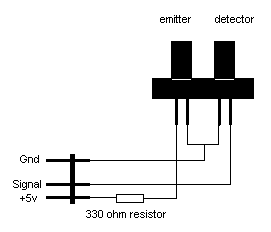|
This tutorial will look
at how you can use feedback to control and regulate the speed of
motors (or anything else that rotates). Let's say that you want your
robot to travel at a steady speed that uses 60% power to the motors.
This constant power supply would work fine on flat ground but what
would happen if it encountered a hill, would it have enough power to
handle a steep incline or would it slow to a crawling speed.
This problem could be
overcome with feedback. If you could somehow sense the rotational
speed of the wheels you could deliver more power to the motors if they
slow down (climbing a hill or overcoming an object) or apply some
breaking if they are rotating too fast (travelling down hill), but
always maintaining a steady speed.
 I'm
going to talk about using shaft encoder's record how fast the wheels
are turning. I'm
going to talk about using shaft encoder's record how fast the wheels
are turning.
Shaft encoders use infra
red emitters and detectors that are placed fairly close to each other
(about half an inch or less). When there is a direct line of sight
between them the detector is 'on' and produces a voltage (normally
around 1 to 3 volts). When the line of sight is blocked the detector
doesn't pick up any infra red light so is 'off', producing 0 volts.
For a perfect example of
how shaft encoders work take a look inside your mouse. You will see a
disk with holes around the edges. On either side of the disk are an
infra red emitter and infra red detector. When you move the mouse, the
mouse ball's rotation causes the perforated disk to rotate. As the
disk rotates the path between the IR emitter and detector is made and
broken, causing the detector to create a string of electrical pulses.
By monitoring the frequency of the pulses you can deduce how far the
wheel has turned and the time it took.
 Shaft encoders for robots use
exactly the same principle. A card disk similar to the one on the
right can attached to the drive shaft of the wheel and used to break
an IR beam between the emitter and detector. Shaft encoders for robots use
exactly the same principle. A card disk similar to the one on the
right can attached to the drive shaft of the wheel and used to break
an IR beam between the emitter and detector.
The diagram below shows
how to connect the shaft encoder available in the components section
of the Robologic shop to the Robocore. The disk rotates through the
'U' of the sensor and creates an electrical pulse at the signal line
every time the IR beam is made of broken. The only external component
needed is a 330 ohm resistor.

A good feature of using
shaft encoders to monitor wheel movement is that they are totally
friction free, meaning that there is no loss of drive power when they
are used.
If the pre-moulded 'U'
design does not fit your specifications then the sensor can be
constructed from separate emitter and detector components wired in the
same was as above and mounted on your own design. The emitter and
detector may need to be shielded with some black card or something
similar to prevent them from detecting any ambient infra red. |